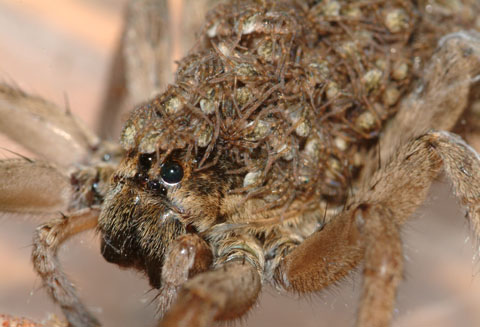Interactions
The Schizocosa mccooki interacts with many different
species. Some common interactions are with other wolf spiders
(Alopecosa kochi and Pardosa tuoba), humans. The
interaction with the A. kochi wolf spider is a little different
and maybe a tad bit unexpected. The A. kochi wolf spider lives
mostly in the forested area, but sometimes finds its way to the
where the meadow and the forest meet (Suttle, 2003). Common
plants that the A. kochi spider lives along side with
in the forests are the
White Willow and
Licorice Fern. While the S. mccooki wolf
spider’s habitat is in
the meadow, where it interacts with plants such as the
Jimson Weed,
Stinging Nettles,and
Dandelions, they sometimes make their way to the edge of the
meadow near the forest where
English Ivy maybe hiding the A. kochi. When these two spiders find eachother something you may
not expect to happen happens. The S. mccooki attacks and
viciously consumes the A. kochi spider (Suttle, 2003). There is one other wolf
the P. tuoba who lives almost exclusively in the transitional
area between the forest and the meadow (Suttle, 2003). And this wolf spider is
the smallest wolf spider and is always killed and eaten by both
the other two wolf spiders. So the S. mccooki wolf spider’s
interactions with other wolf spiders is pretty violent, but how
does it interact with humans? The S. mccooki is very aggressive
toward humans as well, actually. If threatened or touched the
spider will bite the attacker with long fangs. The bite is not
lethal to humans, but it can be very painful! The bite can cause
pain and irritation, the skin near the point of the bite may
even turn black (Sharp, 2013). The S. mccooki wolf spider may be extremely
aggressive toward insects, such as
Deer Ticks,
mosquitos, and the
damselfly. The S. mccooki maybe the apex
predator when it comes to other insects in its habitat, it is no
match for larger predators such as the
american bull frog. Although the S. mccooki tends
to be a very solitary organism, interactions in the wild are
essential for living whether it be for mating or nutritonal
value.
between the forest and the meadow (Suttle, 2003). And this wolf spider is
the smallest wolf spider and is always killed and eaten by both
the other two wolf spiders. So the S. mccooki wolf spider’s
interactions with other wolf spiders is pretty violent, but how
does it interact with humans? The S. mccooki is very aggressive
toward humans as well, actually. If threatened or touched the
spider will bite the attacker with long fangs. The bite is not
lethal to humans, but it can be very painful! The bite can cause
pain and irritation, the skin near the point of the bite may
even turn black (Sharp, 2013). The S. mccooki wolf spider may be extremely
aggressive toward insects, such as
Deer Ticks,
mosquitos, and the
damselfly. The S. mccooki maybe the apex
predator when it comes to other insects in its habitat, it is no
match for larger predators such as the
american bull frog. Although the S. mccooki tends
to be a very solitary organism, interactions in the wild are
essential for living whether it be for mating or nutritonal
value.
To learn about Reproduction click HERE